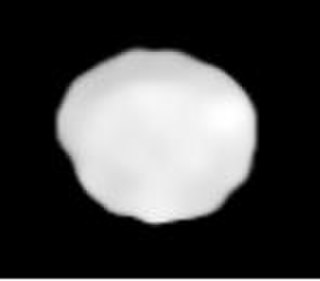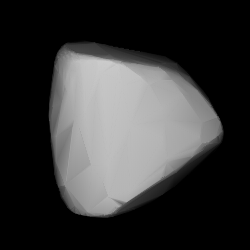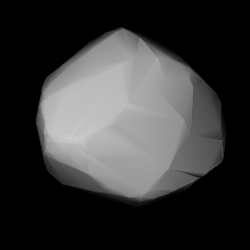
Fortuna is one of the largest main-belt asteroids. It has a composition similar to 1 Ceres: a darkly colored surface that is heavily space-weathered with the composition of primitive organic compounds, including tholins.

Hekate is a large main-belt asteroid.

Hera is a moderately large main-belt asteroid with an orbital period of 4.44 years. It was discovered by Canadian-American astronomer James Craig Watson on September 7, 1868, and named after Hera, queen and fifth in power of the Olympian gods in Greek mythology. This is a stony S-type asteroid with a silicate surface composition.
Dione is a large main-belt asteroid. It probably has a composition similar to 1 Ceres. It was discovered by J. C. Watson on October 10, 1868, and named after Dione, a Titaness in Greek mythology who was sometimes said to have been the mother of Aphrodite, the Greek goddess of love and beauty. It is listed as a member of the Hecuba group of asteroids that orbit near the 2:1 mean-motion resonance with Jupiter. The orbital period for this object is 5.66 years and it has an eccentricity of 0.17.

Dejopeja is a large M-type Main belt asteroid. It was discovered by Johann Palisa on February 28, 1878, and was named after Deiopea, a Roman nymph.

Hersilia is a fairly large Main belt asteroid. It was discovered by C. H. F. Peters on October 13, 1879, in Clinton, New York. The asteroid was named after Hersilia, Roman wife of Romulus. It is classified as a primitive, dark carbon-rich C-type asteroid.

Aschera is a Main belt asteroid. It was discovered by Austrian astronomer Johann Palisa on February 29, 1880, in Pola and was named after the Sidonian goddess Asherah.

Asterope is a large main-belt asteroid that was discovered on 11 May 1883, by French astronomer Alphonse Borrelly at Marseille Observatory in Marseille, France. The asteroid was named after Asterope, one of the Pleiades.

283 Emma is a large asteroid of the asteroid belt and the namesake of the Emma family. It was discovered by Auguste Charlois on 8 February 1889, in Nice, France. The reason for its name is unknown.

Polyxo is a main-belt asteroid that was discovered by A. Borrelly on March 31, 1891, in Marseilles. It is orbiting the Sun at a distance of 2.75 AU with a low orbital eccentricity (ovalness) of 0.04 and a period of 4.56 yr. The orbital plane is tilted at an angle of 4.36° to the plane of the ecliptic.

Phyllis is a minor planet orbiting the Sun. It is an S-type asteroid with a diameter of 38 km and a geometric albedo of 0.185. Based on photometric observations between 1998 and 2006, it has a synodic rotation period of 4.293 ± 0.001 hours. The asteroid is named after Phyllis, a character in Greek mythology.
941 Murray is a background asteroid, approximately 18 kilometers in diameter, located in the central region of the asteroid belt. It was discovered by Austrian astronomer Johann Palisa at the Vienna Observatory on 10 October 1920. The X-type asteroid has a short rotation period of 3.4 hours. It was named after British professor Gilbert Murray (1866–1957).
110393 Rammstein, provisional designation 2001 TC8, is a background asteroid from the central region of the asteroid belt, approximately 4 kilometers in diameter. It was discovered on 11 October 2001, by French astronomer Jean-Claude Merlin at the Le Creusot Observatory in France. The asteroid was named after the German industrial metal band Rammstein.
2007 McCuskey, provisional designation 1963 SQ, is a carbonaceous asteroid from the inner regions of the asteroid belt, approximately 22 kilometers in diameter. It was discovered on 22 September 1963, by astronomers of the Indiana Asteroid Program at Goethe Link Observatory near Brooklyn, Indiana, United States. The asteroid was later named after American astronomer Sidney McCuskey.

77185 Cherryh, provisional designation 2001 FE9, is a background asteroid from the central regions of the asteroid belt, approximately 4 kilometers (2.5 miles) in diameter. It was discovered on 20 March 2001, by American amateur astronomers Don Wells and Alex Cruz at the George Observatory in Needville, Texas. The dark asteroid was named for American writer C. J. Cherryh.
(35671) 1998 SN165, prov. designation: 1998 SN165, is a trans-Neptunian object from the Kuiper belt located in the outermost region of the Solar System. It was discovered on 23 September 1998, by American astronomer Arianna Gleason at the Kitt Peak National Observatory near Tucson, Arizona. The cold classical Kuiper belt object is a dwarf planet candidate, as it measures approximately 400 kilometers (250 miles) in diameter. It has a grey-blue color (BB) and a rotation period of 8.8 hours. As of 2021, it has not been named.
24626 Astrowizard, provisional designation 1980 TS3, is a dark background asteroid from the central regions of the asteroid belt, approximately 7 kilometers in diameter. It was discovered on 9 October 1980, by American astronomer couple Carolyn and Eugene Shoemaker at the Palomar Observatory in California, United States. The asteroid was named for American science educator David Rodrigues, who would perform at public events as "The Astro Wizard".
151997 Bauhinia, provisional designation 2004 JL1, is a sub-kilometer background asteroid from the inner regions of the asteroid belt, approximately 900 meters in diameter. It was discovered on 11 May 2004, by Canadian astronomer William Yeung at the Desert Eagle Observatory, Arizona, United States. It was named after the flowering plant Bauhinia blakeana also known as the "Hong Kong Orchid Tree".
(444030) 2004 NT33 is a classical trans-Neptunian object and possible dwarf planet of the Kuiper belt in the outermost region of the Solar System, approximately 450 kilometers in diameter. It was discovered on 13 July 2004, by astronomers at Palomar Observatory, California, United States.
(523639) 2010 RE64, provisional designation 2010 RE64, is a trans-Neptunian object in the scattered disc located in the outermost region of the Solar System, approximately 570 kilometers (350 miles) in diameter. It was discovered on 11 July 2010 by the Pan-STARRS-1 survey at the Haleakala Observatory, Hawaii, in the United States.











